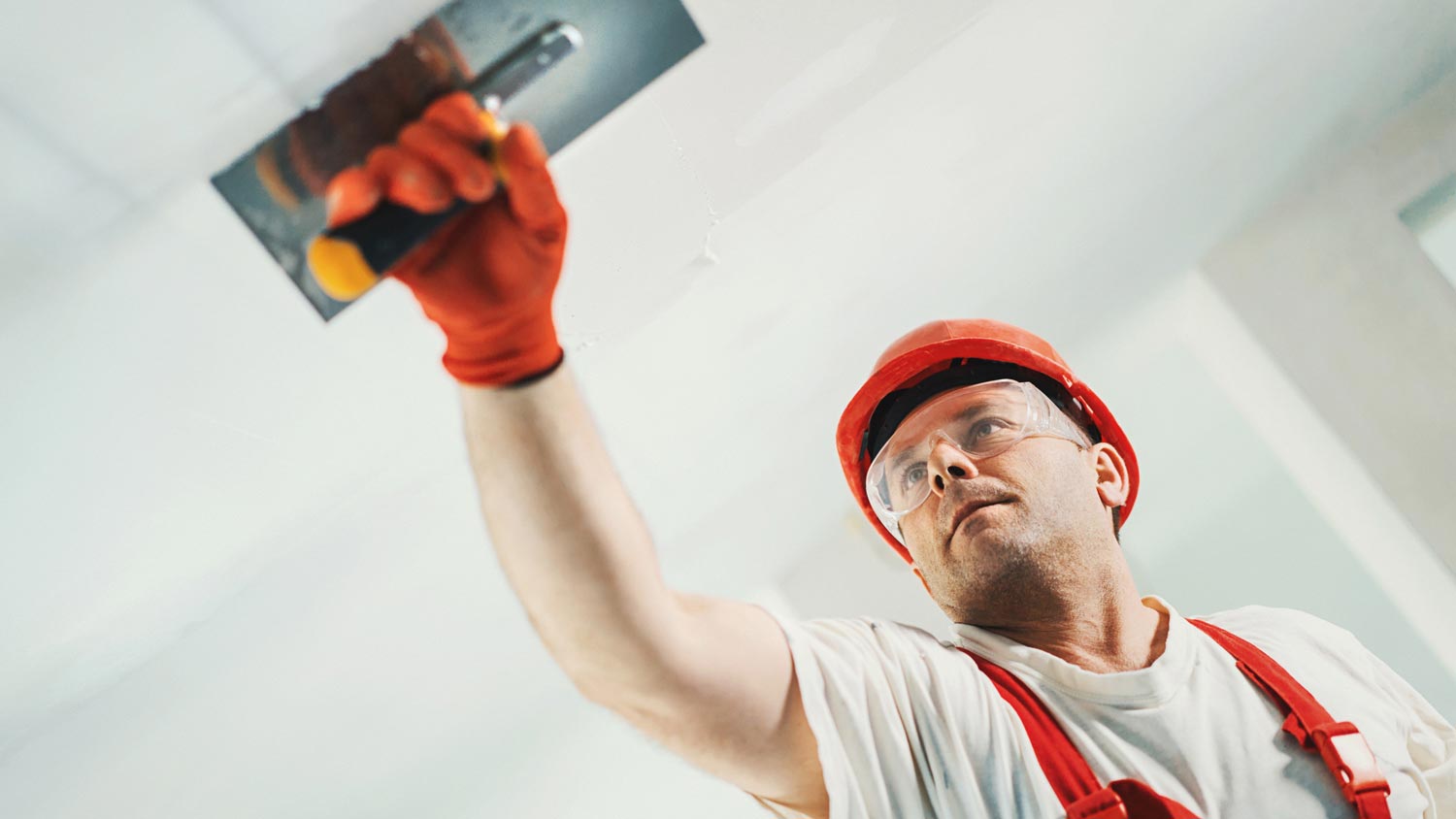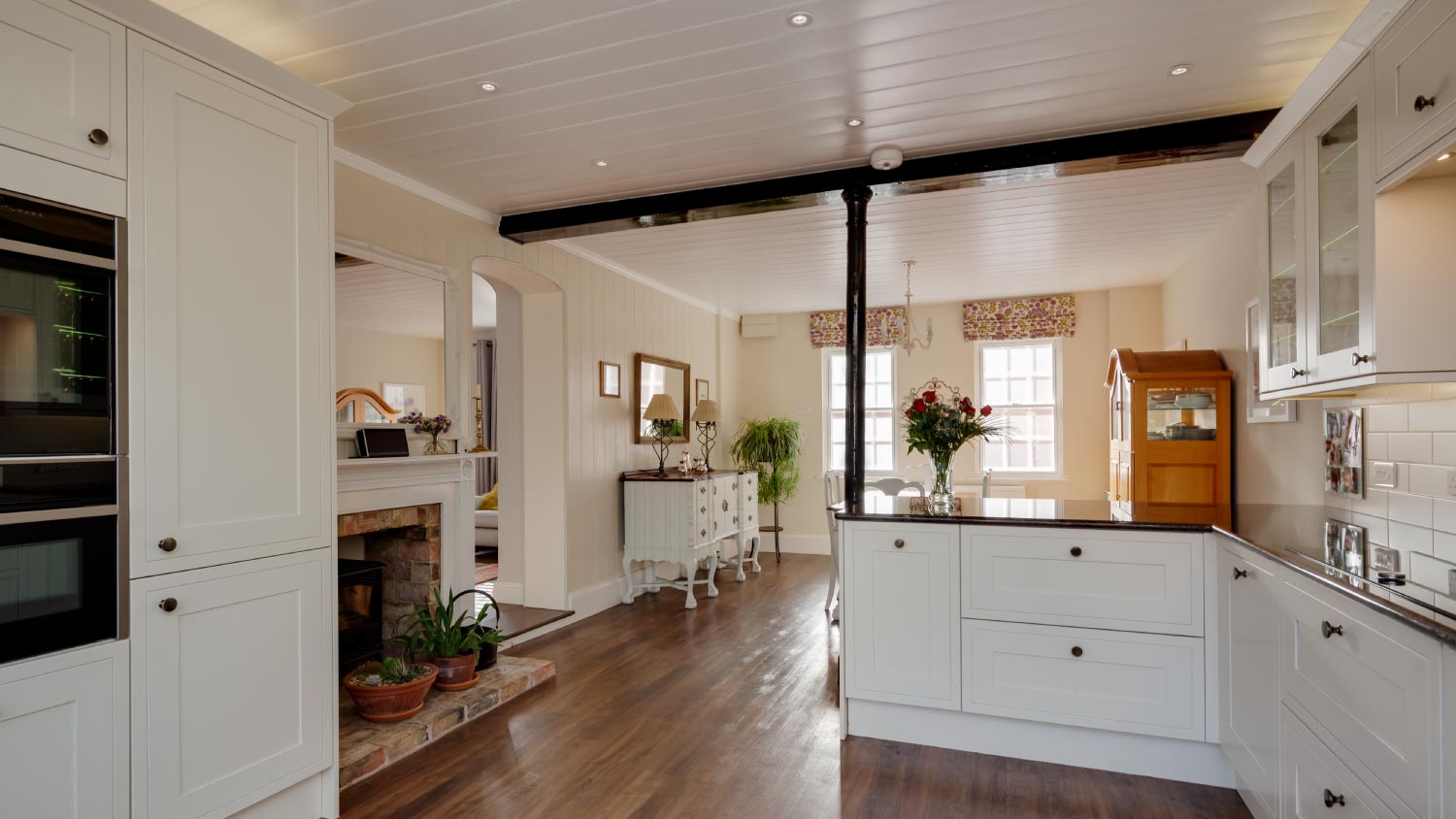
Skim coating drywall is a great alternative to replacement, and is often more affordable. Use this guide to estimate the cost to skim coat walls in your home.
The type of drywall mud and a variety of other factors influence drying time


The three most common types of drywall mud are pre-mixed, setting-type, and lightweight joint compound.
Pre-mixed and lightweight joint compounds take at least 24 hours to dry per coat, but setting-type can take as little as 20 minutes to dry.
Create a room temperature between 60°F and 70°F to speed up drying time.
Apply thin coats of drywall mud to speed up how fast it dries.
Getting any type of home project done quickly always feels like a win, but sometimes you can’t jump ahead even if you’re in a rush. Drywall mud, also known as joint compound or simply "mud," plays a crucial role in the process of finishing and repairing drywall surfaces. How long does drywall mud take to dry? Whether you're a DIY enthusiast or choose to hire a professional drywall installer near you, understanding how long drywall mud takes to dry is essential for planning your project.
In this article, we'll explore the factors that influence drying times, the different types of drywall mud, and tips to expedite the drying process.
The time it takes for your drywall to dry will depend heavily on the type of mud you use. Here is a rough estimate of drying times for different types of drywall mud:
| Mud Type | Description | Average Drying Time |
|---|---|---|
| Pre-mixed joint compound | Convenient for beginners and small projects, but it may have a longer drying time than other types. | 24 hours per coat |
| Setting-Type Joint Compound | Hardens quickly, making it great for deep fills, patching, and working in high-humidity conditions. | 20 to 45 minutes |
| Lightweight Joint Compound | Not the quickest drying time, but it’s easier to sand and is best for final coats or high walls and ceilings. | 24 hours per coat |

Several factors can influence how long it takes for drywall mud to dry. Understanding these variables will help you estimate drying times more accurately:
Type of mud: As mentioned earlier, the type of drywall mud you use significantly affects drying times. Pre-mixed mud tends to dry more slowly than setting-type joint compound.
Humidity: Humidity levels in your environment play a crucial role. Higher humidity can slow down drying, while lower humidity speeds it up. Consider using a hygrometer to monitor humidity.
Temperature: Warmer temperatures generally promote faster drying. Colder environments can extend the drying process. Aim for a room temperature between 60°F and 70°F for optimal results.
Application thickness: The thickness of the mud layer applied to the drywall matters. Thicker layers take longer to dry, so use thinner coats for quicker results.
Ventilation: Proper ventilation can accelerate drying. Ensure that the room is well-ventilated with fans or open windows to circulate air.
Drywall type: The type of drywall you are working on can affect your drying time. Standard drywall and moisture-resistant drywall may have slightly different drying rates.
Hot drywall mud is designed specifically to dry quickly, making it ideal for when you're looking to get a project done fast. Because it's fast-drying, make sure to practice on a small area first to get the right thickness.

When it comes to expediting the drywall mud-drying process, a few strategic approaches can make a significant difference. These tips not only help to save time but also to ensure a smoother finish on your drywall:
Choose the right setting type: If your project's timeline is a critical factor, consider using a setting-type joint compound. This type of mud is designed to dry rapidly and is an excellent choice when you need to move quickly. It starts setting within 20 to 45 minutes, allowing you to apply subsequent coats on the same day. However, remember to work efficiently, as it doesn't provide the same extended working time as pre-mixed mud.
Optimize room conditions: The environment in which you're working plays a substantial role in drying times. To encourage faster drying, maintain ideal room temperature and humidity levels. Aim for a room temperature between 60°F and 70°F and humidity levels around 40% to 50%. Use dehumidifiers or heaters if necessary to regulate humidity and ensure a consistent temperature throughout the drying process.
Thin coats for speed and smoothness: When applying drywall mud, it's tempting to use thicker coats to save time, but this can actually slow down the drying process. Instead, opt for thin coats of mud. Multiple thin coats will dry faster and more evenly than a single thick one. Thin coats also reduce the risk of cracks and imperfections in the finish levels on your drywall.
Enhance ventilation: Proper ventilation is key to expediting drying times. Improve airflow in the room by strategically placing fans to circulate air over the drying mud. Additionally, consider opening windows or doors to create cross-ventilation. Improved ventilation not only speeds up the evaporation of moisture but also helps maintain a balanced room environment, reducing the risk of bubbles or blemishes in the mud.
Use heat lamps carefully: In certain situations, heat lamps can be used to expedite drying, especially in colder or high-humidity environments. However, use them cautiously to avoid overheating the mud, which can lead to cracking or other finish imperfections. Keep heat lamps at a safe distance from the drywall surface and monitor the temperature closely. It's advisable to consult manufacturer guidelines for the specific type of drywall mud you are using, as some products may not be suitable for heat exposure
We have hired Honey Interiors to complete multiple projects over several years including crown molding, painting, drywall repair and texture, tile work, plumbing and installation of light fixtures and ceiling fans. The communication is always excellent, scheduling process great and they show...
Larrisa treated my home as if it were her own. I appreciated the time and care that was given.
Had holes in my drywall from the previous owners. Cody came and patched it all up!
They added a subpanel and fixed some shoddy wiring downstairs replaced the upstairs panel, upgraded the home service to 200A, and took care of the permit with the city. They nailed it on pretty much everything. There were some small drywall cuts that weren’t put back but that’s the only con.
DFG Drywall replaced old tape, textured a new surface, and painted my 20+ year old garage making it new. They did a fabulous job at a great price. They fit me in their schedule and completed the project quickly. I would definitely hire them again.
These guys do great work. In and out in less than 24 hours. So impressed. When I called, they answered on the second ring, at 2:30 in the morning! Whoâ d does that? They were professional, clean, well spoken, fair in how they priced things and very deliberate and upfront in explaining...
Started immediately. Did a great job fixing and finishing drywall.
Tanner was very helpful & professional when I called with a last minute request. He was able to make that happen for me! I’m very grateful for having someone like him & was able to get my drywall work done in a professional manner and the work looks fabulous!
David replaced the water damaged drywall on the ceilings and walls. He applied the mud and tape and sanded everyhing to perfection. The rooms are now ready to paint. David does an awesome professional job. His price was fair and below the other bids I recieved. I highly recommend David Wilber...
Hired Williams for drywall repair in some areas of the house as well as taping and texturing a bathroom remodel. Turned out great! I did a terrible job hanging the sheetrock and he made it look great! We will use him in the future as we continue our home improvement cause you always need a...
From average costs to expert advice, get all the answers you need to get your job done.

Skim coating drywall is a great alternative to replacement, and is often more affordable. Use this guide to estimate the cost to skim coat walls in your home.

Installing drywall is the most common way to finish your home’s interior. Use this drywall installation cost guide to see what your project is likely to cost.

Installing beadboard ceilings is a great DIY project. Learn what to expect cost-wise from this project, whether removing or covering a popcorn ceiling.

Studs can be found in a number of ways—you don’t always need a stud finder. Learn which methods are the most accurate, helping you find studs hidden behind a blank wall.

With advances in technology, there are more drywall options than ever. This article will help you weigh the pros and cons of lightweight vs. standard drywall.

How hard is it to hang drywall? It’s certainly not easy and there are potential pitfalls if you plan on going the DIY route. Read this guide for helpful tips.